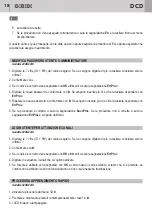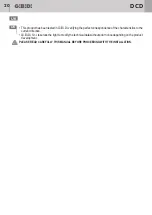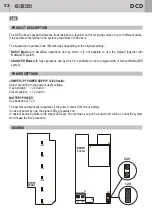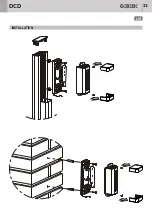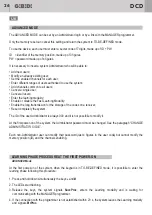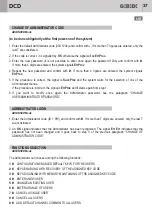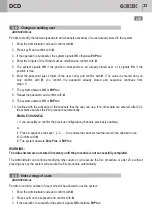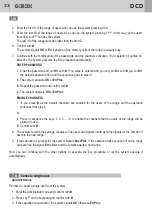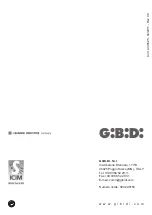
26
27
UK
UK
DCD
DCD
ADVANCED MODE
The ADVANCED MODE can be set by an Administrator login or by a link with the MANAGER programmer.
Only the memory reset can cancel this setting and return the system to TO-BE-DEFINED mode.
To use the device, each user must enter a secret code of 7 digits, made up of ID + PW:
ID = identifier of the memory position, made up of 3 figures.
PW = password made up of 4 figures.
It is necessary to insert a system Administrator who will be able to:
• Add new users;
Modify an already existing user;
Set the enabled channels for each user;
Enter different ranges of users authorized to use the system;
Add channels common to all users;
Cancel a single user;
Cancel all users;
Enter the learning modality;
Enable or disable the Fast Learning Modality;
Enable the long transmission for the storage of the codes on a receiver;
Reset completely the system.
The ID of the user Administrator is always 000 and it is not possibile to modify it.
At the first power-on of the system, the Administrator password must be changed. See the paragraph “CHANGE
ADMINISTRATOR CODE”.
Each non-Administrator user can modify their password (last 4 figures in the user code) but cannot modify the
memory position (ID) and the channels enabling.
•
•
•
•
•
•
•
•
•
•
At the first power-on of the system, when the keypad is in TO-BE-DEFINED mode, it is possibile to enter the
learning phase following this procedure:
1. Press and hold down simultaneously the keys and
#
.
*
2. The LEDs start flashing.
3. Release the keys, the system signals
SuccProc
, enters the Learning modality and is waiting for
communicating with the MANAGER programmer.
4. If the connection with the programmer is not established within 20 s, the system leaves the Learning modality
and signals
ErrProc
.
(to be done obligatorily at the first power-on of the system)
1. Enter the default Administrator code (000 1234) and confirm with . If more than 7 figures are entered, only the
*
last 7 are considered.
2. If the code is correct, it is signalled by
OK
, otherwise the signal will be
ErrProc
.
3. Enter the new password (it is not possibile to enter once again the password 1234) and confirm with
#
.
If more than 4 digits are entered, the system signals
ErrProc
.
4. Repeat the new password and confirm with
#
. If more than 4 figures are entered, the system signals
ErrProc
.
5. If the procedure is correct, the signal is
SuccProc
and the system waits for the selection of one of the
Administrator menus.
If the procedure is incorrect, the signal is
ErrProc
and it starts again from step 1.
6. If you want to modify once again the Administrator password, see the paragraph “CHANGE
USER/ADMINISTRATOR PASSWORD”.
1. Enter the Administrator code (ID + PW) and confirm with
#
. If more than 7 digits are entered, only the last 7
are considered.
2. An
OK
signal indicates that the Administrator has been recognized. The signal
Err Err
indicates that the
password has not been changed and it goes back to step 3 of the previous paragraph “CHANGE OF
ADMINISTRATOR CODE”.
LEARNING PHASE PROCEDURE AT THE FIRST POWER-ON
CHANGE OF ADMINISTRATOR CODE
ADMINISTRATOR LOGIN
ADVANCED Mode
ADVANCED Mode
ADVANCED Mode
The Administrator can choose among the following functions:
1 #
CONFIGURATION ENABLED DEFAULT KEYS FOR THE USERS
2 #
KEYS ENABLING WITH RECOVERY OF THE ASSIGNED KEY CODE
3 #
KEYS DISABLING WITH MEMORY MAINTAINING OF THE ASSIGNED KEY CODE
4 #
ENTER A NEW USER
5 #
CHANGE AN EXISTING USER
6 #
ENTER A RANGE OF USERS
7 #
CANCEL A SINGLE USER
8 #
CANCEL ALL USERS
9 #
ADD DEFAULT CHANNEL COMMON TO ALL USERS
FUNCTIONS SELECTION
ADVANCED Mode
Summary of Contents for GiBiDi DCD 100
Page 5: ...INSTALLAZIONE 5 I DCD...
Page 23: ...INSTALLATION 23 UK DCD...
Page 38: ...38 NOTE NOTES DCD...
Page 39: ...39 NOTE NOTES DCD...







